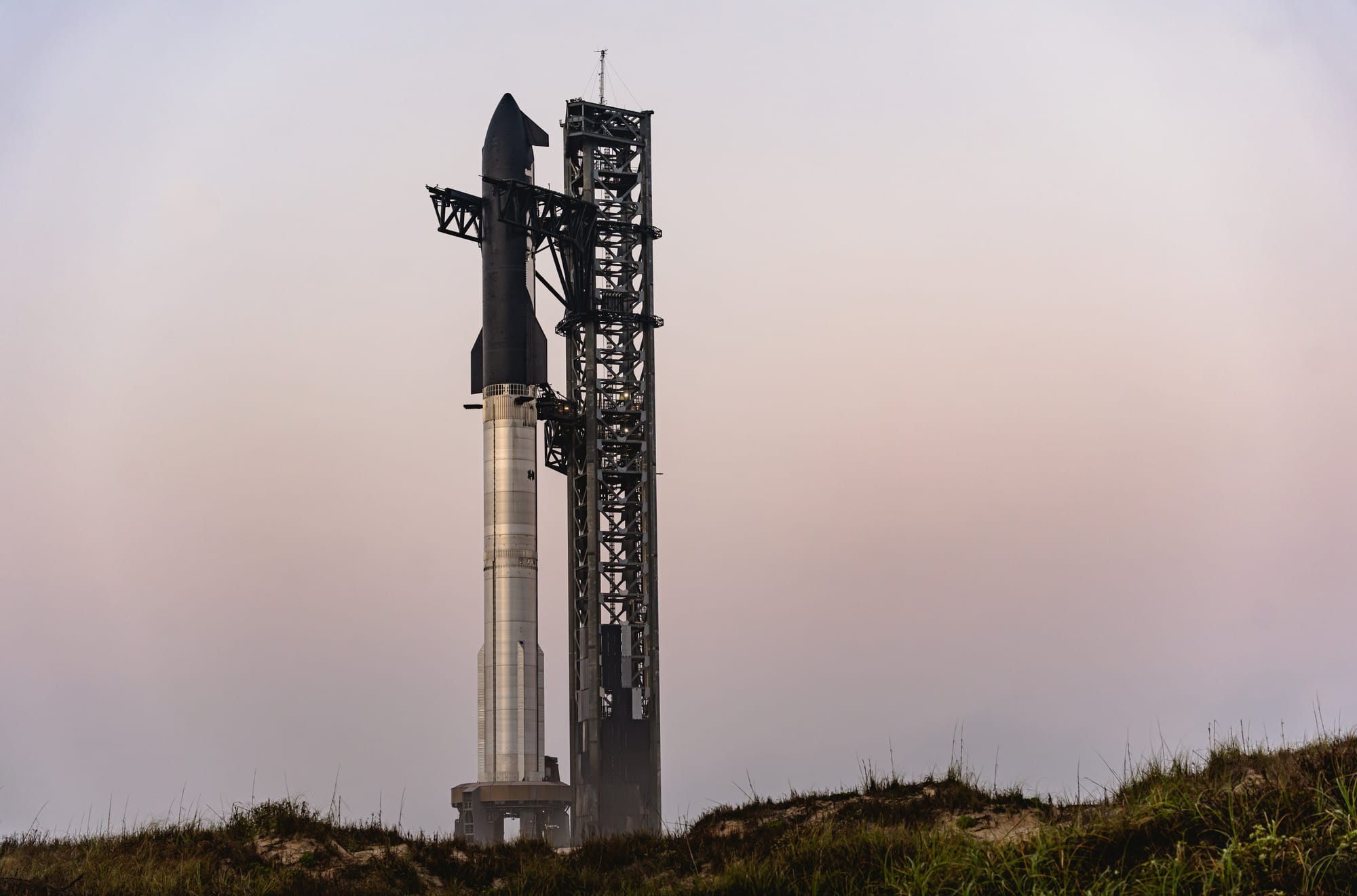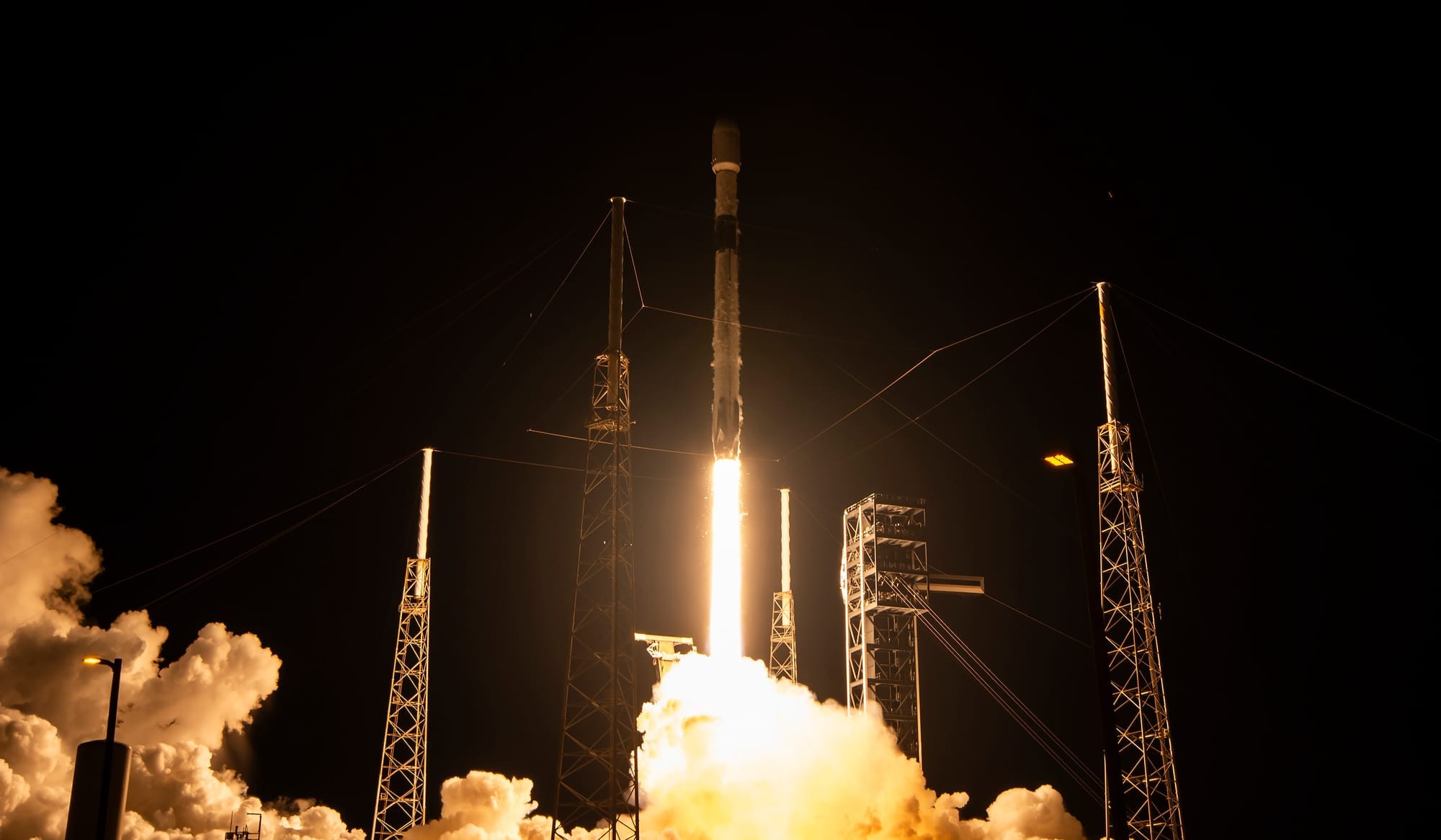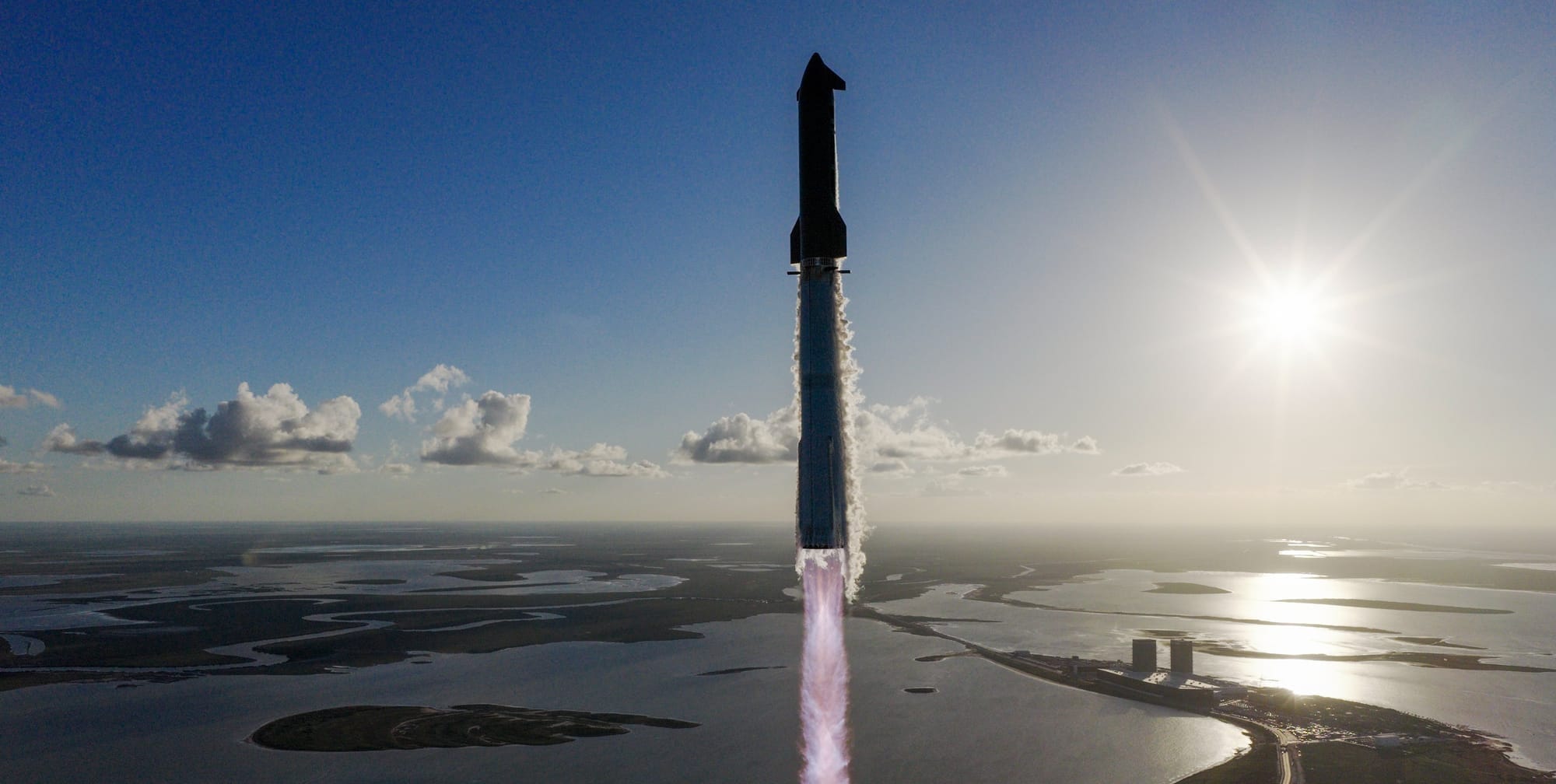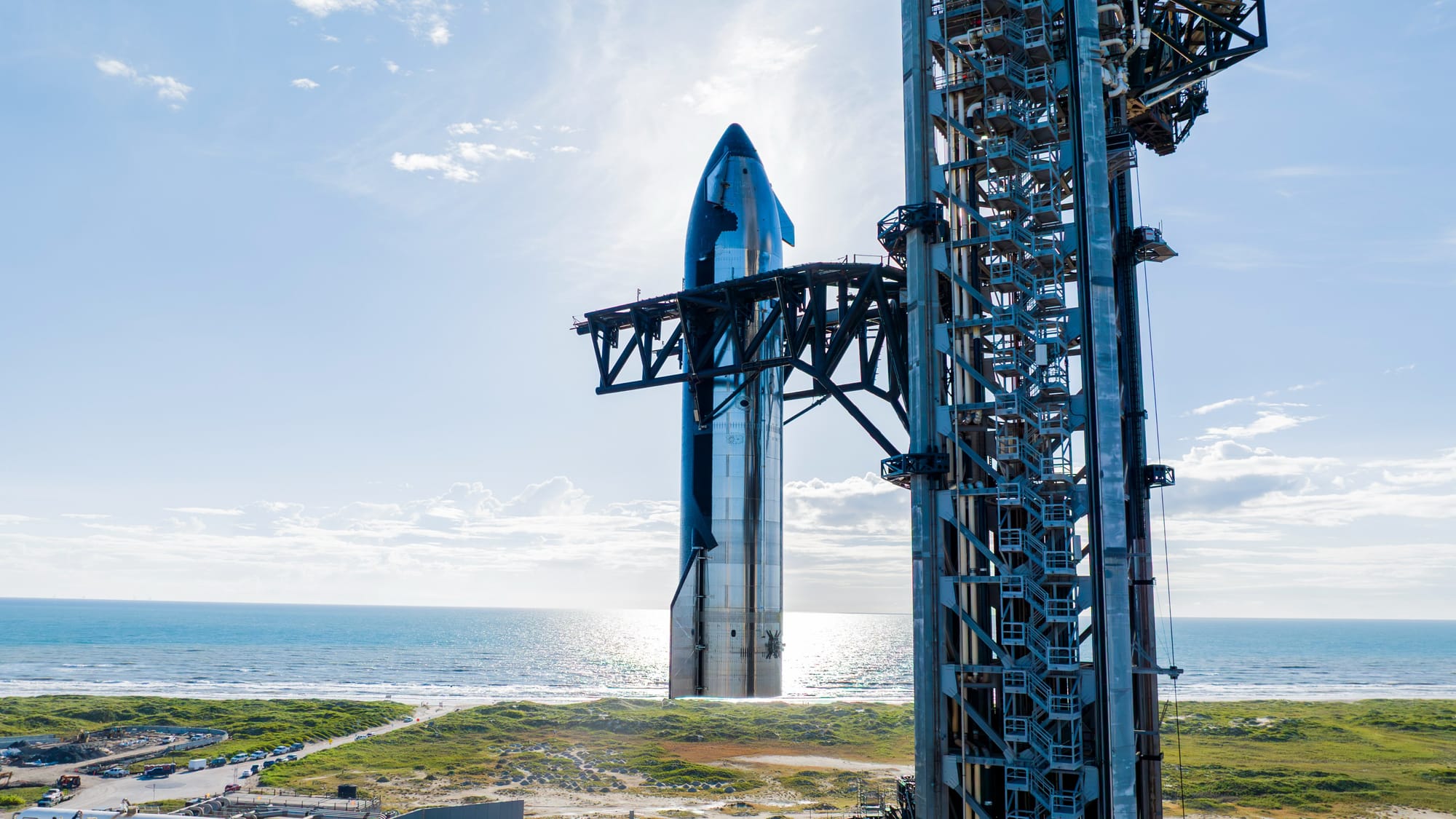Table of Contents
SpaceX conducted Starship-Super Heavy's eighth flight test yesterday, lifting off at 23:30 Universal Coordinated Time. This flight test was utilizing Ship 34, the second 'Block 2' Starship upper-stage, and Super Heavy Booster 15.
As with previous flight tests, Super Heavy Booster 15 lit all thirty-three of its Raptor engines, blasting off from SpaceX's Starbase launch site, near Boca Chica in south Texas, and heading out over the Gulf of Mexico.
Liftoff of Starship! pic.twitter.com/OL7moLdZ2u
— SpaceX (@SpaceX) March 6, 2025
Starship-Super Heavy lifting off for its eighth flight test, via SpaceX on Twitter.
Booster 15's Raptor engines remained running as planned up until hot-staging, where all but three were shut off. With three engines running on the booster, Ship 34 staged, and Booster 15 began heading back to the launch site.
Starship’s Raptor engines ignite during hot-staging separation. Super Heavy is boosting back towards the launch site pic.twitter.com/9oK3m4xJaq
— SpaceX (@SpaceX) March 6, 2025
Ship 34 staging from Booster 15 during ascent, via SpaceX on Twitter.
For the boost-back burn to return, two Raptor engines failed to restart, but that did not prevent a return. After a few minutes of unpowered flight, Booster 15 relit twelve out of thirteen engines for a catch, rapidly slowing down before dropping down to three. With three engines running, the booster maneuvered between the launch tower's arms for the Starship program's third catch!
Mechazilla has caught the Super Heavy booster! pic.twitter.com/JFeJSdnQ5x
— SpaceX (@SpaceX) March 6, 2025
Booster 15 being caugt back at the launch site, via SpaceX on Twitter.
While the booster was flying as expected, Ship 34 was beginning to run into problems. Near Starship engine cutoff, a fire was observed spreading in the engine bay with debris falling away. After a little while, Raptor engines, both sea level and vacuum, began to fail, inducing a violent spin. This spin, or the triggering of the flight termination system, resulted in the breakup of the vehicle.
Engine failure on stage two - Activate DRA's now!
— (@scottmanley.bsky.social) 2025-03-06T23:40:08.038Z
Ship 34 tumbling in space following failure of various systems, via Scott Manley on Bluesky.
SpaceX had been planning to fly Ship 34 to the Indian Ocean for a reentry and landing. On the way there, four Starlink simulators were planned to be deployed.
#Starship reentering as viewed from Cape Canaveral, Florida. #FLwx pic.twitter.com/4FvcVGIBa1
— Nick Stewart (@NStewWX) March 6, 2025
Debris from Ship 34 seen reentering from Florida following its loss, via Nick Stewart on Twitter.
Shortly after the failure, SpaceX took to Twitter to state the following:
During Starship's ascent burn, the vehicle experienced a rapid unscheduled disassembly and contact was lost. Our team immediately began coordination with safety officials to implement pre-planned contingency responses.
We will review the data from today's flight test to better understand root cause. As always, success comes from what we learn, and today’s flight will offer additional lessons to improve Starship's reliability.
The failure of Ship 34 is incredibly similar to Ship 33 during the seventh flight test. This begs a few questions, did SpaceX properly find the root cause of the failure? Did Ship 34 have proper mitigations installed? And is SpaceX conducting proper pre-flight QA checks?
Due to the similarities of the failures, the U.S. Federal Aviation Administration may open an extensive investigation into Starship-Super Heavy before allowing it to fly again.
Flight nine had been expected to head into orbit should the eighth flight succeed. An orbital flight is now pushed back to flight ten at the earliest, likely in the second half of the year.
SpaceX had been planning to conduct Starship-Super Heavy's first mission into orbit in the coming months as well as a Ship-to-Ship propellant transfer demonstration. Both of these missions are critical milestones for NASA's Artemis III mission, which is planned to be the first Crewed mission to the Lunar surface since 1972.
How does it compare to flight seven?
For the seventh flight test, Booster 14 ignited all thirty-three Raptor engines, propelling the vehicle toward space. All engines ran until 'most engines cut-off,' at which point Ship 33 lit its six engines for hot staging. Booster 14 then performed a boost back burn, heading back to the launch site.
Mechazilla has caught the Super Heavy booster! pic.twitter.com/aq91TloYzY
— SpaceX (@SpaceX) January 16, 2025
Booster 14 during its tower catch at Starbase, via SpaceX on Twitter.
Following the end of the boost back burn, Booster 14 descended back toward the launch site, lighting thirteen engines and then shutting down all but three for a second successful catch of the Starship program.
As the booster was flying as planned, Ship 33 was running into several problems. Over several minutes, Ship 33's Raptor engines gradually failed one by one and almost nine minutes into flight, telemetry from the vehicle was lost. SpaceX claims Ship 33 was lost due to harmonic stresses which damaged propulsion systems.
What is Starship-Super Heavy?
Starship-Super Heavy is SpaceX's in-development fully reusable super heavy-lift launch vehicle and the largest rocket currently flying. SpaceX is currently aiming to have the launch vehicle deliver one-hundred and fifty tons to low Earth orbit while reused or two-hundred and fifty tons when expended, although there are rumors from SpaceX of an expendable payload capacity of three-hundred tons.
On the launch pad, Starship-Super Heavy is one-hundred and twenty-four meters tall and weighs 5,000,000 kilograms fully fuelled. The diameter of both vehicles is nine meters, excluding aerodynamic control surfaces.
What is Starship?
Starship is the second-stage of the Starship-Super Heavy launch vehicle and is planned to be capable of multiple missions into orbit, after a short refurbishment. The vehicle is fifty meters tall and nine meters in diameter, excluding its four aerodynamic control surfaces. Fully fuelled with liquid methane and liquid oyxgen Starship is believed to weigh 1,300,000 kilograms with an approximate weight of 100,000 kilograms unfuelled.
The Starship second-stage is powered by three sea-level Raptor engines along with three vacuum-optimized Raptor engines. These sea-level engines are believed to generate 230 tons of thrust each with the vacuum-optimized engines generating 258 tons of thrust each for a total combined 1,500 tons of thrust for Starship. The vacuum-optimized Raptors are unable to gimbal requiring the sea-level Raptors for control of the second-stage on ascent and landing.
In order to survive re-entry for reuse, Starship has several thousand thermal protection tiles on one side of the vehicle and on all four of its aerodynamic control surfaces. The four control surfaces help guide the vehicle during re-entry and prior to landing inside the atmosphere at a pre-determined location. Starship also has a series of small thrusters to control the vehicle in space before re-entry.
SpaceX is believed to be working on a few variants of Starship for use as a Moon lander, propellant tanker, space station, Mars lander, and as a crewed spacecraft.
What is Super Heavy?
Super Heavy, also called 'the Super Heavy booster', is the first-stage of SpaceX's Starship-Super Heavy launch vehicle. The giant Super Heavy first-stage is planned to be capable of multiple flights per day with minimal refurbishments and inspections. The vehicle is seventy-one meters tall and nine meters in diameter, excluding its four grid fins and chines. Fully fuelled with liquid methane and liquid oyxgen Super Heavy is believed to weigh 3,600,000 kilograms with an approximate mass of 200,000 kilograms unfuelled.
The Super Heavy first-stage is powered by thirty-three sea-level Raptor engines generating a combined thrust of 7,590 tons, with each engine generating 230 tons of thrust. The outer twenty Raptor engines are unable to gimbal with the inner thirteen being able to for control of the first-stage.
To enable the reuse of Super Heavy, the vehicle has four large grid fins placed in the interstage to assist in guiding and controlling during descent. Super Heavy also has four chines running along the lower third of it to generate lift and assist in stabilization.
Shortly after completing the ascent, Super Heavy relights ten engines, as three were running during staging, and performs a 'boost back' burn in order to return to the launch site. After the 'boost back' burn is completed the engines shut down with Super Heavy being guided by a series of small thrusters and its grid fins. Once Super Heavy is at the correct altitude above its landing location three engines start back up for the landing burn. SpaceX currently plans to have Super Heavy land in the ocean with launch site landing attempts happening with later flights.
Super Heavy also features a hot-staging ring atop of it to allow for a faster and simpler staging process, according to SpaceX. The hot-staging ring has dozens of gaps on the sides to allow for the Raptor engine exhaust of Starship to escape.






